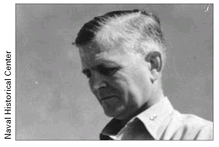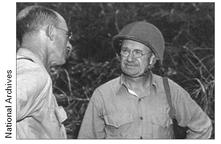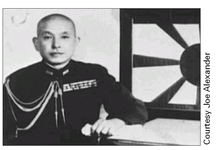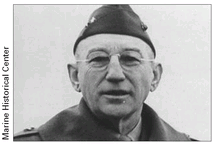War Stories II (43 page)
Authors: Oliver L. North

These engagements were fought as conventional land battles, supported by Navy cruiser/destroyer surface action groups and land-based Army, Navy, and Marine aircraft. While Halsey was slugging his way to the northwest, his lack of carriers forced him to seize and build little island airstrips. General George Kenney, commanding MacArthur's 5th Air Force, was building a virtual air armada of first-rate, land-based Army Air Force fighters and bombers supported by hundreds of transport aircraft. By the fall of 1943, Kenney's airmen were ranging hundreds of miles from Australia and Papua, attacking Japanese ships, bases, troop concentrations, and supply depots at will. On 2 November, Kenney sent seventy-five B-25 Mitchell bombers and eighty P-38 Lightnings to raid Rabaul itself, sinking more than a dozen Japanese ships, damaging twenty others, and destroying ninety-four of the emperor's planes in the air. On the ground, American losses totaled eight B-25s and nine P-38s.
Â
Admiral Harry Hill

That same night, in the Battle of Empress Augusta Bay, U.S. cruisers commanded by Admiral Stanton Merrill and a destroyer division led by Captain Arleigh Burke turned away a Japanese counter-invasion force of cruisers, destroyers, and transports attempting to interdict General Vandegrift's amphibious landing on Bougainville. The following day, Admiral Halsey sent carrier aircraft from
Saratoga
and the light carrier USS
Princeton
to bomb the Japanese fleet anchored at Rabaul. On 11 November, he did it againâadding the carriers
Essex
,
Independence
, and
Bunker Hill
âa five-carrier raid that lasted for hours, wrecking the Japanese base.
Saratoga
and the light carrier USS
Princeton
to bomb the Japanese fleet anchored at Rabaul. On 11 November, he did it againâadding the carriers
Essex
,
Independence
, and
Bunker Hill
âa five-carrier raid that lasted for hours, wrecking the Japanese base.
These engagements were little noted by an American press corps focused on the bloody Allied campaign in Italy. But for the Joint Chiefs, the operations demonstrated how dramatically the balance of power had shifted in the South Pacific since the beginning of the year. Even though the war in Europe was still the first priority, with Rabaul effectively neutralized, it was finally time to start a new drive toward Japanâthis time in the central Pacific.
While Halsey and MacArthur were battling their way north, determined to isolate Rabaul as they aimed for the Philippines, Nimitz had been slowly building up his forces in Hawaii. By November 1943, American industry was churning out hundreds of airplanes a day, bigger and faster ships, thousands of landing craft, and hundreds of thousands of fresh soldiers, sailors, airmen, Coast Guardsmen, and Marines.
Over MacArthur's vehement objections, Nimitz convinced the Joint Chiefs that a new drive through the central Pacific should become the main axis of attack against Japan. For MacArthur, holding tight to his goal to liberate the Philippines, it was a bitter pill to swallow. But once the Chiefs decided, they made sure that Nimitz got what he needed, particularly the new
Essex
-class fleet carriers capable of carrying more than a hundred of the latest Navy aircraft: Grumman F6F “Hellcat” fighters, Curtiss SB2C “Helldiver” bombers, and F4U “Corsairs,” which the Japanese had taken to calling “Whistling Death.” Nimitz also got better submarines, now equipped with new torpedoes and commanded by bolder skippers who were decimating the Japanese merchant marine fleet. By November 1943, at fleet anchorages in Pearl Harbor, Midway, and the Ellice Islands, he had nineteen carriersâlight, medium, and heavyâtwelve battleships, fourteen cruisers, and fifty-six destroyers.
Essex
-class fleet carriers capable of carrying more than a hundred of the latest Navy aircraft: Grumman F6F “Hellcat” fighters, Curtiss SB2C “Helldiver” bombers, and F4U “Corsairs,” which the Japanese had taken to calling “Whistling Death.” Nimitz also got better submarines, now equipped with new torpedoes and commanded by bolder skippers who were decimating the Japanese merchant marine fleet. By November 1943, at fleet anchorages in Pearl Harbor, Midway, and the Ellice Islands, he had nineteen carriersâlight, medium, and heavyâtwelve battleships, fourteen cruisers, and fifty-six destroyers.
To support and supply themâand to land his Marine and Army assault troopsâNimitz also assembled more than 200 other vessels: twenty-nine fast attack transports, scores of new LST and LSD amphibious assault ships, dozens of fleet oilers, repair ships, ocean-going tugs towing fuel barges, hospital ships, tenders, and hundreds of smaller PT boats, landing craft, and tracked amphibious assault vehicles.
With all this combat power, Nimitz was ready for Operation Galvanic. The plan called for his 5th Amphibious Force to seize three tiny atolls in the Gilberts 2,600 miles west of Hawaii, near the intersection of the equator and the International Date Line. Some described these little spits of land as “the first stop past the middle of nowhere,” and they all had, like so many other places in the vast Pacific, strange-sounding names: Abemama, Makin, and Tarawa.

The plan of attack approved by Nimitz was fairly simple: Fast carrier forces would isolate the three atolls from the threat of any Japanese reaction coming from Truk or the Marshalls. They would then conduct preâD-day aerial attacks to destroy any Japanese aircraft at their seaplane base on Makin and the airfield being built on Betio Island in the Tarawa atoll.
After the battleships “softened up” fortifications ashore, Admiral Kelly Turner's 5th Amphibious Force would simultaneously storm Makin and Tarawa. The ground force, designated as the 5th Amphibious Corps, commanded by Marine Major General Holland M. Smith, consisted of the 18,000-man, reinforced 2nd Marine Division for the Tarawa assault and 6,700 soldiers of the Army's 27th Infantry Division to secure Makin, 100 miles to the north. The U.S. submarine
Nautilus
would land a Marine rifle company on lightly defended Abemama. It would be the only part of Operation Galvanic that went according to plan.
Nautilus
would land a Marine rifle company on lightly defended Abemama. It would be the only part of Operation Galvanic that went according to plan.
Â
Major General Holland M. Smith

On 13 November, B-24 Liberators of the 7th Air Force began a weeklong series of bombing raids to “soften up” both Makin and Tarawa. Then, the night before the landings, seven battleships and nine cruisers began pounding both Makin and Betio in a pre-assault bombardment unlike anything ever tried before by the U.S. Navy. Everyone, including the Marines watching
offshore, assumed that it would be enough to pulverize the defenses ashore. They were wrong.
offshore, assumed that it would be enough to pulverize the defenses ashore. They were wrong.
The man Tokyo entrusted to defend the Gilbert Islands, forty-nine-year-old Rear Admiral Keiji Shibasaki, commanded a mixed force of 2,900 elite naval infantrymen (similar to our Marines), about 1,500 armed construction troops (like the U.S. Navy's Seabees), and 1,500 conscripted Korean laborers. He dispatched 284 of the naval infantry and about 500 of the construction troops and laborers to Makin. The rest, about 4,000 in all, were packed into bunkers and revetments on the narrow two-mile spit of land called Betio Island at the south end of Tarawa atollâwhere the British had started an airstrip before Japan seized the Gilberts on 7 December 1941.
Â
Admiral Keiji Shibasaki

By the time Admiral Hill and his Marines arrived offshore, Shibasaki and his troops had been working on the Betio defenses and airstrip for months. He had once asserted that his troops could “hold Tarawa against a million Americans for a hundred years.” They built massive concrete blockhouses, bunkers covered with six feet of coconut logs and sand, dug sheltered trench lines and tank traps, and constructed more than 400 mutually supporting bombproof gun emplacements and machine gun positions. His shore-based artillery, manned by instructors from the Imperial Artillery School, boasted eight-inch, five-inch, and smaller caliber naval guns and mortarsâall with pre-registered targets on the coral reef surrounding Betio.
And Shibasaki knew what the Americans did not: The coral reef was itself a formidable natural barrier that would prevent almost any landing craft from crossing at any time other than a very high tide. To make matters worse for the Americans, the naval planners in Pearl Harbor decided to conduct Operation Galvanic during a “neap tide”âthe time of month when the alignment of the sun, moon, and Earth create lower than usual tides. For the Marines going ashore on Betio, it would prove to be a very costly error.
 U.S. 5TH AMPHIBIOUS FORCE
U.S. 5TH AMPHIBIOUS FORCEBETIO ISLAND, TARAWA ATOLL
20 NOVEMBER 1943
1800 HOURS LOCAL
20 NOVEMBER 1943
1800 HOURS LOCAL
Major General Julian C. Smith, the 2nd Marine Division's commander, had insisted on a massive pre-invasion bombardment before his troops hit Betio's narrow beach. He got what he asked for. His Marines, many of them veterans of the Guadalcanal campaign, had been treated to a pre-dawn breakfast of steak and eggs and were circling outside the reef in their landing craft and LVTs when the sixteen-inch guns of the battleships and the cruisers' eight-inch guns had opened up at 0500. The ear-shattering barrage went on for more than an hour as more than 2,500 tons of high-explosive shells rained down on the little island. Then, at 0610, the naval gunfire lifted so the carrier aircraft could deliver another 900 tons of bombs and strafe the landing beaches. After the dive-bombers and fighters finished their work, the naval gunfire resumed again until 0845, when Admiral Hill ordered a cease-fire for fear of hitting the LVTs and Higgins boats as the men of the assault wave headed for their landing beaches.
Â
Major General Julian C. Smith

Other books
A Lot Like a Lady by Kim Bowman, Kay Springsteen
A Crazy Day with Cobras by Mary Pope Osborne
A Little Scandal by Cabot, Patricia
JENNY GOES HOLLYWOOD by Madison Langston
Holiday Fling by Victoria H. Smith
Hallowe'en Party by Agatha Christie
Programming Python by Mark Lutz
The Fourth Horseman by David Hagberg
The Stars Shine Bright by Sibella Giorello
Rancher at Risk by Barbara White Daille
